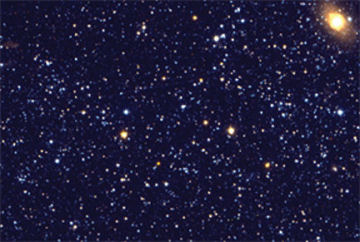Galactic Growth Spurts
A newly discovered galaxy that grew in fits and starts is like no other galaxy known.
Share this:
- Share via email (Opens in new window) Email
- Click to share on Facebook (Opens in new window) Facebook
- Click to share on X (Opens in new window) X
- Click to share on Pinterest (Opens in new window) Pinterest
- Click to share on Reddit (Opens in new window) Reddit
- Share to Google Classroom (Opens in new window) Google Classroom
- Click to print (Opens in new window) Print
By Emily Sohn
Galaxies are like people. They grow when they’re young and stop growing when they settle into adulthood. Now, scientists have discovered a galaxy that’s been growing in fits and starts. Its name is Leo A.
After the galaxy formed, it grew normally. But it soon stopped growing until about halfway through its life, according to new evidence from the Hubble Space Telescope. Then, surprisingly, Leo A started growing again.
 |
|
Small dots are stars in the dwarf galaxy Leo A, and yellowish blobs are other, distant galaxies in the background. Most of the stars in Leo A didn’t form until 7 billion years ago, long after the galaxy experienced its first growth spurt. |
| Andrew A. Cole, et al./NASA |
The strange-growing galaxy “has the potential to change the way astronomers build theoretical models for galaxy evolution,” says Andrew Cole of the University of Minnesota in Minneapolis.
Leo A is 2.6 million light-years from Earth, which is relatively close as galaxies go. It is so small that scientists refer to it as a dwarf galaxy. Cole and his colleagues observed Leo A using Hubble’s sharpest camera, the Advanced Camera for Surveys. That camera died in February, but the scientists were able to look at Leo A before the glitch happened.
The Hubble data revealed something odd: Only 10 percent of Leo A’s stars are ancient. The rest didn’t start burning until about 7 billion years ago.
It appears, the scientists suggest, that Leo A was lying low from some time after the Big Bang 13.7 billion years ago until about 7 billion years ago, when growth resumed. Scientists have never seen another galaxy like it.
Leo A is different from previously studied dwarf galaxies in other ways too. For one thing, it has no large galaxies nearby to disturb it. And because it is close to Earth, it’s a good place to study when scientists want to test new theories about how galaxies form.
“We really don’t know how different Leo A might be from other isolated galaxies; it could be that the delay turns out to be a common feature,” Cole says.
The scientists are trying to determine why Leo A took such a long break. They’ve already suggested one possible reason. Stars form in galaxies when the gas inside is cold. Hubble’s data, however, show that warm gas spread throughout Leo A.
Cole suspects that an ancient string of explosions might have warmed the galaxy and squelched star formation for a long time.
What brought back its growth spurt 7 billion years ago? That remains a mystery.—E. Sohn
Going Deeper:
Cowen, Ron. 2007. Late bloomer: Hubble studies once-dormant galaxy. Science News 171(March 31):195-196. Available at http://www.sciencenews.org/articles/20070331/fob2.asp .
Sohn, Emily. 2007. Space camera glitch. Science News for Kids (Feb. 7). Available at http://www.sciencenewsforkids.org/articles/20070207/Note3.asp .






